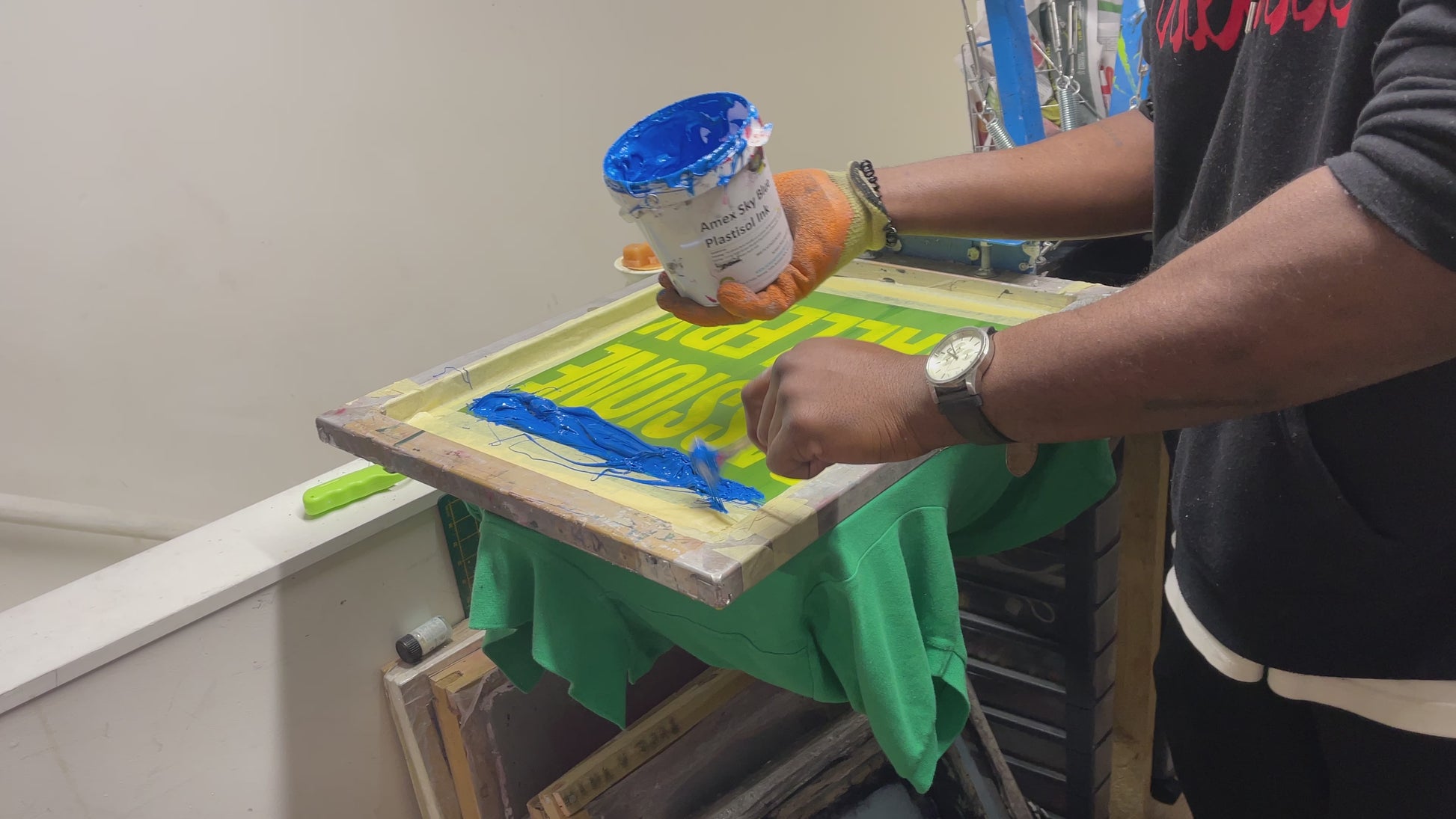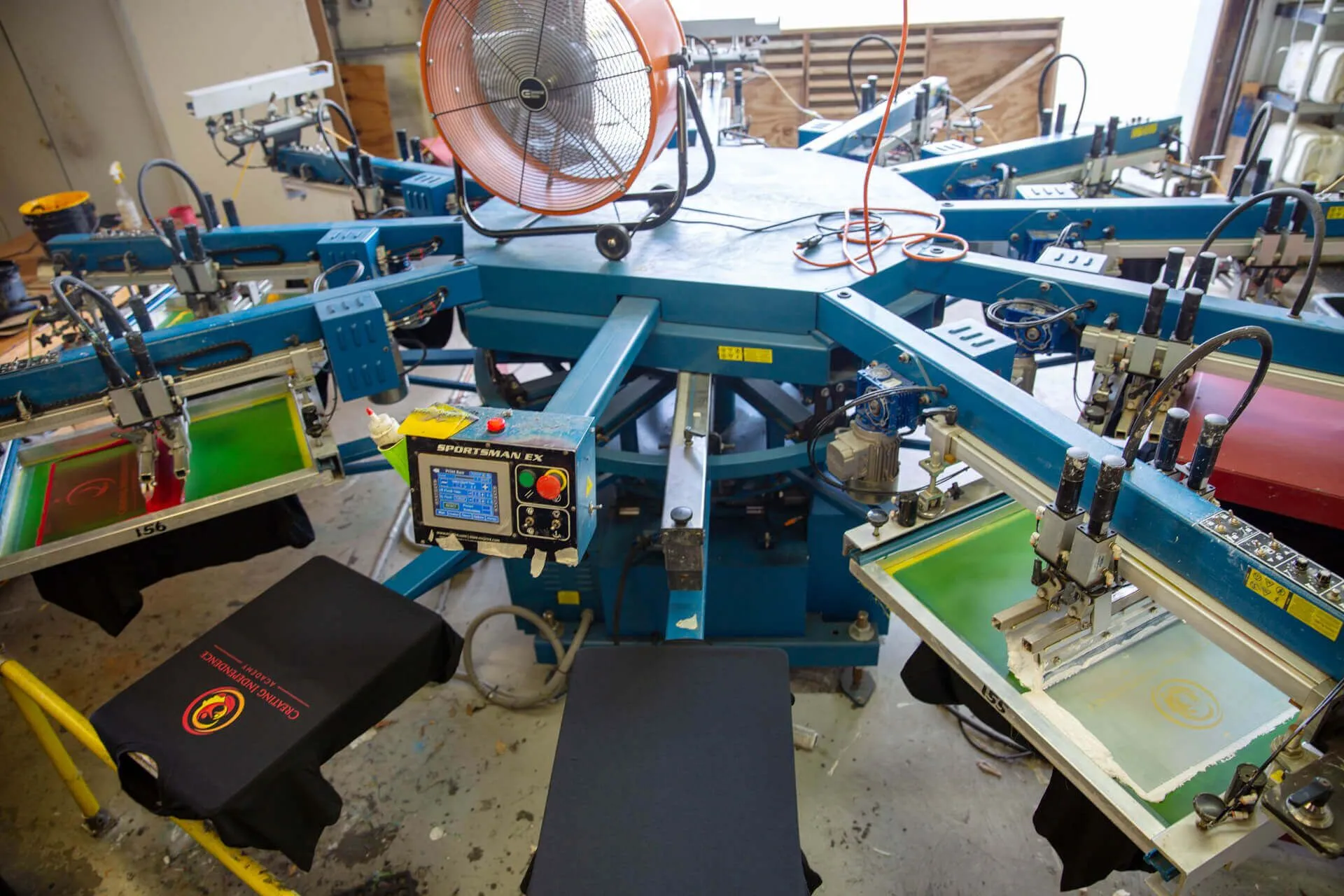Screen Printing Uncovered: Every Little Thing You Need to Find Out About T-Shirt and Garment Printing Techniques
Display printing is an interesting technique that integrates art with technique, providing unlimited possibilities for creative thinking. All set to discover the essential components that make display publishing an art kind?
The Essentials of Display Printing: Just How It Works
When you dive right into display printing, you'll uncover it's both a scientific research and an art. At its core, screen printing includes producing a stencil, or display, that allows ink to pass through just in details locations.
Following, you'll mix your inks and prepare your printing surface. Placement the screen over the fabric, after that utilize a squeegee to press ink with the display onto the garment. This process needs precision, as you want clear, vibrant prints. After printing, you'll heal the ink with warm, guaranteeing it follows the textile and lasts with cleans. Each action is crucial, and understanding them will elevate your display printing skills, transforming simple garments into one-of-a-kind, expressive items.
Kinds Of Screen Printing Methods
Once you understand the fundamentals of screen printing, it's time to check out the different techniques that can elevate your styles. One prominent approach is traditional display printing, where ink is pressed through a stenciled screen.
Another option is plastisol printing, recognized for its resilience and vivid shades, making it a favorite for several brands. Experiment with halftone printing to develop gradient results and elaborate layouts.
Necessary Equipment for Display Printing
To accomplish stunning outcomes in display printing, having the ideal equipment is basic. You'll need a sturdy display printing structure, which holds the mesh that moves your design onto the garment. Next off, buy top notch squeegees; these are necessary for applying ink uniformly throughout the screen. You'll additionally require an excellent exposure device to produce your screens, along with a washout booth for cleansing them after usage. A dependable heat source, like a conveyor dryer or heat press, is essential for healing your prints to ensure long life. Do not fail to remember a proper workspace, outfitted with tables and storage for your materials. Lastly, protective gear, such as masks and handwear covers, will maintain you secure from chemicals and inks. With the right devices, you'll be well on your way to creating professional-quality prints.
Picking the Right Inks and Materials
When selecting inks and products for screen printing, you require to take into consideration the kind of ink that functions ideal for your job. Assume about material compatibility to ensure your styles look last and excellent lengthy. Check out environment-friendly ink alternatives to make your printing process a lot more lasting.
Sorts Of Display Inks
Selecting the ideal screen ink is vital for accomplishing lively, sturdy prints that fulfill your task's needs. There are a number of kinds of display inks to analyze. Plastisol ink is popular for its convenience and convenience of usage, offering outstanding color opacity on dark textiles. Water-based ink, on the other hand, uses a softer feel and is eco-friendly, making it suitable for those looking to decrease their environmental effect. Release inks get rid of dye from the textile, leading to a soft, vintage appearance but need particular handling. Specialized inks, such as glow-in-the-dark or metallic, can include unique effects to your designs. Assess your job needs and pick the ink that straightens ideal with your preferred end result.

Material Compatibility Factors To Consider
Understanding fabric compatibility is important for achieving top quality screen prints, especially considering that various materials react uniquely to different inks. Always check your inks on sample textile to ensure they stick appropriately and maintain color honesty. Furthermore, maintain in mind that fabric weight and appearance can affect the last outcome, so picking the best ink and product combo is important for your task's success.
Eco-Friendly Ink Options
Environment-friendly inks are becoming a preferred option for display printers who want to minimize their ecological effect while keeping high quality. When selecting inks, consider water-based inks, which are much less unsafe and easier to cleanse up contrasted to traditional solvents.
Furthermore, try to find inks made from renewable energies, such as soy or vegetable-based options. By picking the right inks and materials, you'll not only create spectacular styles yet additionally add to a much more lasting printing process. Make the switch, and your prints will mirror your dedication to the setting!
Preparing Your Style for Screen Printing

Submit Format Needs
To guarantee your design looks vivid and sharp on textile, you'll require to pay close interest to file format needs for display printing. Start with vector files like AI or EPS, as they can be scaled without shedding high quality. If you make use of raster pictures, go with high-resolution files, such as TIFF or PNG, preferably at 300 DPI. Prevent using JPEGs, as they can shed quality when resized. Also, ensure your design has a transparent background to stop unwanted white edges on your prints. Keep shade modes in mind; CMYK is standard for display printing, so transform your RGB develops accordingly - screen printing kit. By following these guidelines, you'll establish your artwork up for a successful print.
Shade Splitting Up Techniques
Shade separation is a vital step in preparing your layout for screen printing, and mastering it can significantly enhance your print quality. You'll need to damage your style into specific colors, as each shade needs a different screen during printing. This accuracy not only assures precise color representation yet additionally enhances the printing process.
Resolution and Size
Attaining the very best lead to screen printing starts with guaranteeing your layout has the appropriate resolution and dimension. Ideally, your art work must be at least 300 DPI (dots per inch) for sharp, clear prints. If you utilize reduced resolution, your end product might look amateur and pixelated.
When it pertains to size, take into consideration the dimensions of your print location. Style your art work to match the final print look at here now dimension, ideally developing it in the actual measurements you'll be publishing. This way, you'll prevent any unexpected scaling problems.
Always inspect your design in both vector and raster layouts. Vector graphics can be scaled without losing high quality, making them perfect for screen printing. Preparing appropriately will ensure your layout looks amazing on every garment!
Step-by-Step Display Printing Refine
Display printing is a vibrant procedure that allows you to create lively layouts on various surfaces. To get going, you'll require a display, solution, and your picked ink. First, prepare your screen by cleaning it extensively. Next, apply the emulsion uniformly and allow it completely dry in a dark area. As soon as dry, expose your screen to light with your style put on it, which will certainly set the solution where the light hits, developing a pattern - screen printing kit.
After rinsing the unexposed emulsion, your screen prepares. Establish it up on your printing surface area and straighten your garment under it. Put ink onto the display and make use of a squeegee to press the ink through the stencil onto the fabric. Lift the screen carefully and let the print dry. Cure the ink utilizing warmth to assure toughness. That's it! You have actually effectively display published your design.
Tips for Successful Screen Printing Projects
While you're diving right into your display printing jobs, keep in mind that prep work is essential to success. Begin by collecting all your products-- inks, garments, squeegees, and screens. A clean workspace helps prevent undesirable mistakes, so clean before you start.
Following, validate your artwork is high-resolution and correctly sized for your garment. Evaluate your display for appropriate direct exposure and tidy read review it thoroughly to avoid spots. When mixing your inks, comply with the maker's guidelines to accomplish the right uniformity.
During printing, use even pressure with your squeegee for regular outcomes. Don't hurry; take your time to validate each print meets your criteria. After printing, let your garments completely dry entirely before taking care of or packaging them.
Lastly, always maintain a sample of your benefit future recommendation. In this manner, you can examine your progress and enhance your strategies gradually. Satisfied printing!

Regularly Asked Questions
The length of time Does It Require To Establish up a Display Printing Task?
Establishing up a screen printing task commonly takes around thirty minutes to an hour. You'll prepare the displays, mix inks, and change the press. The time varies based on complexity and experience, so stay arranged!
Can I Print on Different Material Types Making Use Of the Very Same Method?
Yes, you can publish on various material kinds utilizing the very same method, yet you'll need to change your settings and inks. Some textiles absorb ink in Home Page a different way, so experimenting warranties the most effective outcomes for every material.
What Are Usual Errors to Avoid in Screen Printing?
When display printing, prevent typical errors like utilizing the wrong ink, ignoring correct direct exposure times, or missing pre-press checks. Constantly check your setup and keep clean screens to ensure top quality outcomes each time.
Just How Can I Properly Tidy and Maintain My Display Printing Tools?
To appropriately tidy and keep your display printing devices, you must routinely wash displays with ideal solvents, check squeegees for wear, and assure all tools are kept dust-free and completely dry. Consistency boosts and avoids pricey repair work efficiency.
Is Display Printing Eco-friendly Compared to Other Approaches?
Display printing can be more eco friendly than other approaches, especially if you use eco-conscious products and water-based inks. By choosing lasting supplies and techniques, you lower waste and decrease your influence on the world.
Screen Printing Uncovered: Everything You Need to Know Regarding T-Shirt and Garment Printing Strategies
At its core, screen printing includes developing a pattern, or screen, that permits ink to pass via only in particular areas. Position the display over the fabric, then make use of a squeegee to press ink with the display onto the garment. One preferred method is conventional screen printing, where ink is pushed with a stenciled display.When picking inks and products for display printing, you require to take right into account the kind of ink that functions best for your project.